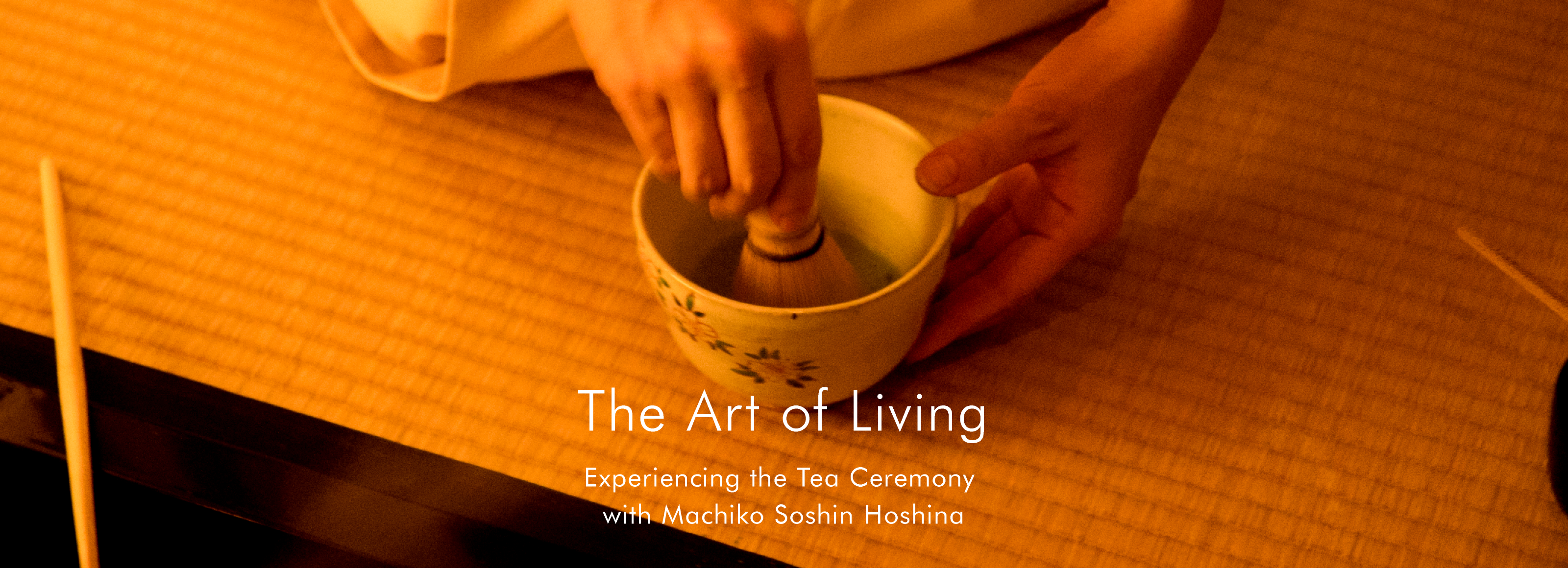
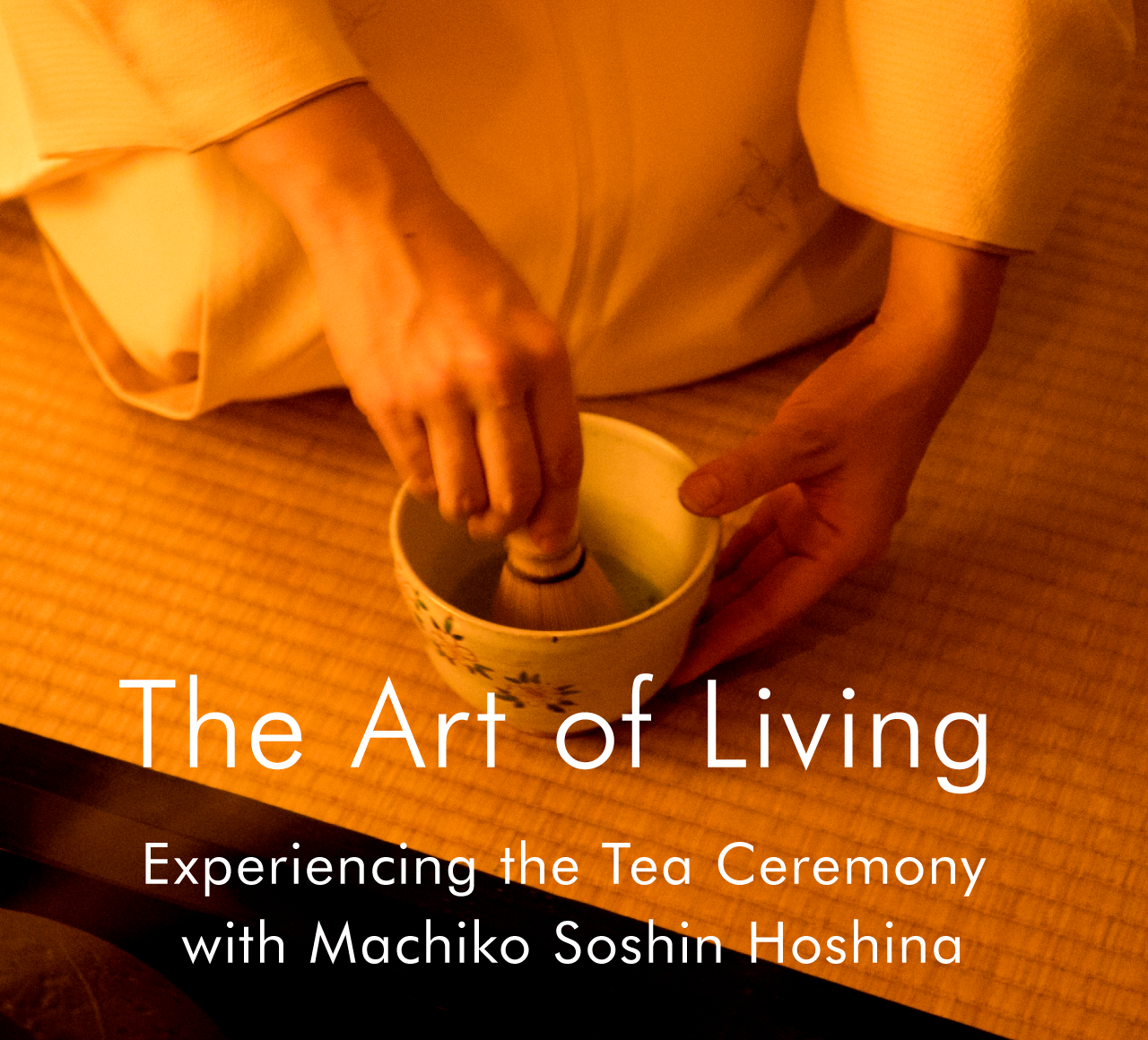
When tea practitioner Machiko Soshin Hoshina consulted on our 2017 Guide to Japanese Tea, she told us so much more about the tea ceremony than we were able to cover on that one page. We decided to catch up with her again, and this time present a full story on the tradition for our online readers. In the short time we spent together Hoshina showed us how a centuries-old ritual and its etiquette are kept very much alive today, and how she shares her knowledge and the Japanese art of living with visitors from abroad.
Our gathering was in November, just after the robiraki ceremony that marks the shift from use of the summertime furo brazier to the sunken hearth. In the tea world, the hearth you see in these photos is used until April.
A descendent of the Tokugawa family and a tea practitioner of the Urasenke style, Machiko Soshin Hoshina conducts tea ceremonies and classes for all ages in English and Japanese at embassies, companies, and schools in Tokyo. For more information or to book an appointment, visit her website: tranquilitea.jp

- Hoshina
- So now we’re ready to enter the tea room. A stand-alone tea house is built with a small door. Known as nijiri-guchi, it required samurai to take off their swords, emphasizing that all who enter are equal. Each person has to stoop low to enter. Here, although it’s a normal height door, guests recognize that same spirit by lowering their body to enter. It might feel odd but you use your arms and abs to propel your body along as you slide on your knees. Keeping your posture low is a show of respect as you move in front of the tokonoma altar, or before your host.
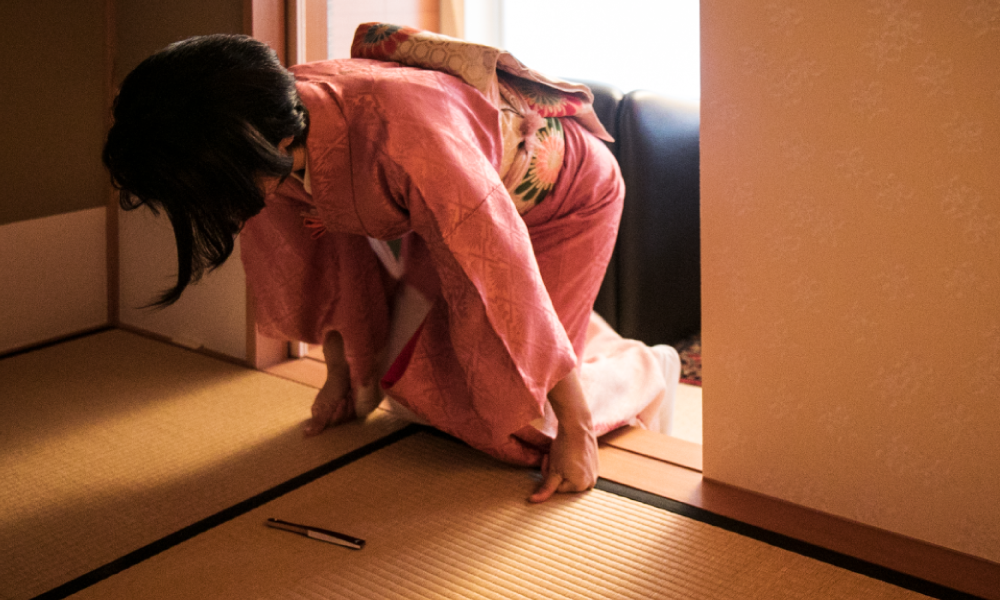
- Hoshina
- Once you enter, take some time to appreciate the jiku hanging scroll. Typically a calligraphic work or painting, it’s hung in the tokonoma to show, or hint at, the host’s theme for the day’s gathering.
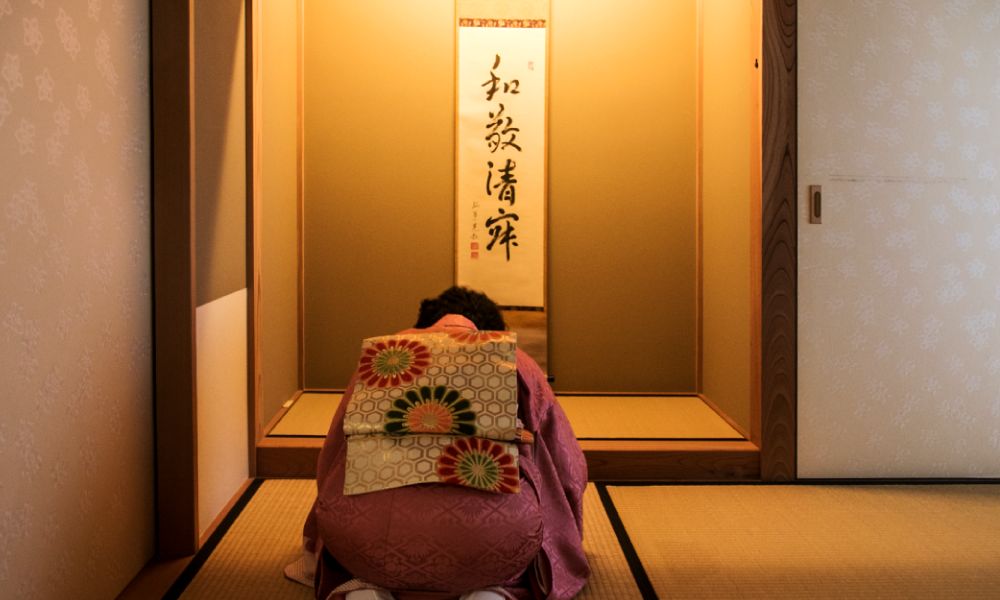
- Hoshina
- Today I chose a scroll that reads, ‘Wa Kei Sei Jaku’. These are the four essential principles underlying the spirit of tea. Wa is harmony. Between people, or in the choice of utensils and other fittings. It also refers to being in harmony with nature. Kei means respect. Respect for each other. The mutual respect of host and guest. Or respect toward nature and the universe. By handling the utensils with respect, we acknowledge the skill of the craftsperson who created this tool for our use. Sei is purity. As we mentioned before, when you go to a shrine, before entering you purify your hands. This is not only for practical reasons; it’s also a symbolic rite.
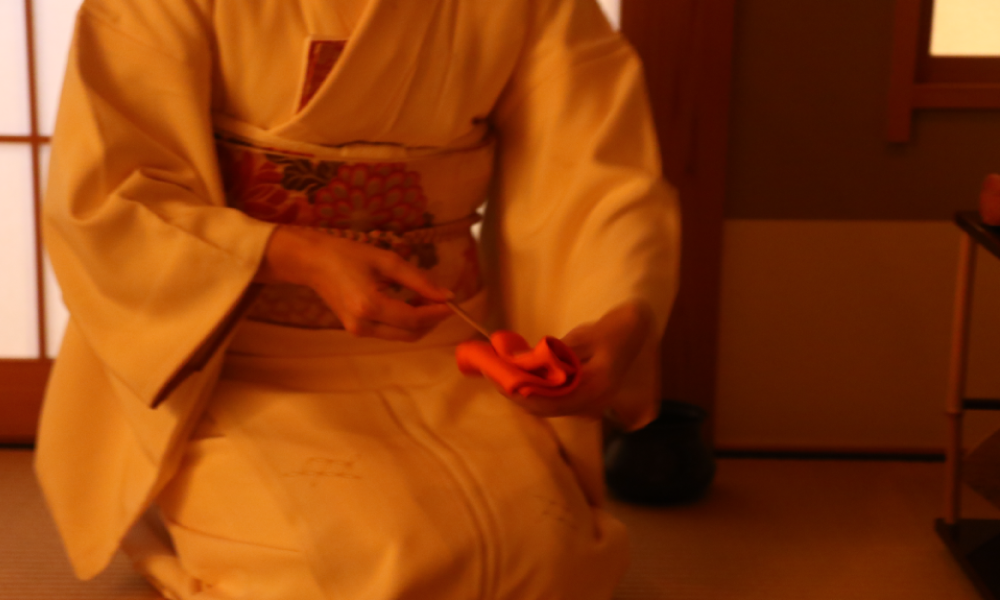
- Hoshina
- For example at one point in the ceremony I use a red silk cloth to purify each utensil. Of course they are already well cleansed beforehand in the preparation room, but showing this symbolic purification to the guest is both an expression of respect and a wish for harmony between us. Finally, Jaku means tranquility. This is the state of mind we aspire to attain after experiencing the first three. If you come away from the tea ceremony having felt these four things, then it was time well spent!
- Hobonichi
- One of the guests has a small folding fan. What does it mean?
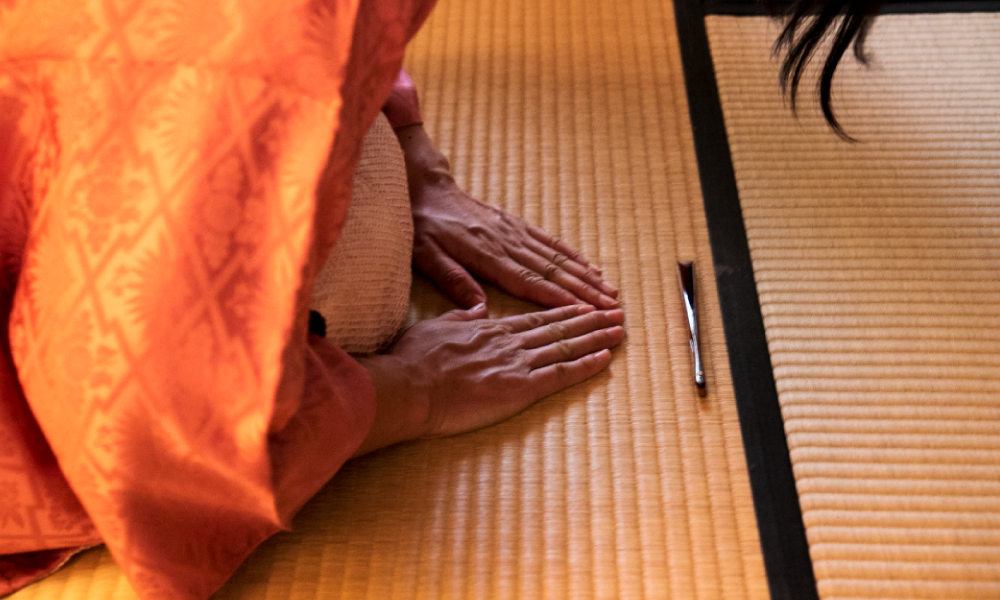
- Hoshina
- The fan marks the boundary between the sacred and the secular, or the worldly life outside of the tea room and the sanctuary inside. So for example, when a guest examines the scroll or takes a closer look at the kettle in the sunken hearth, she will place the fan between the object and herself. It’s a way of showing respect to the people who made the work. When the host enters and the two exchange greetings for the first time, the guest again places her fan parallel to her knees. This, too, is a non-verbal way of showing respect — the fan’s placement shows that you honor the host’s work and won’t overstep that space. Once they’ve greeted each other, the guest places the fan behind her, signaling that the boundary has been removed. Now they can work together to create the feeling of harmony and tranquility in the room. So you see, its role is symbolic.
Laying of the Charcoal
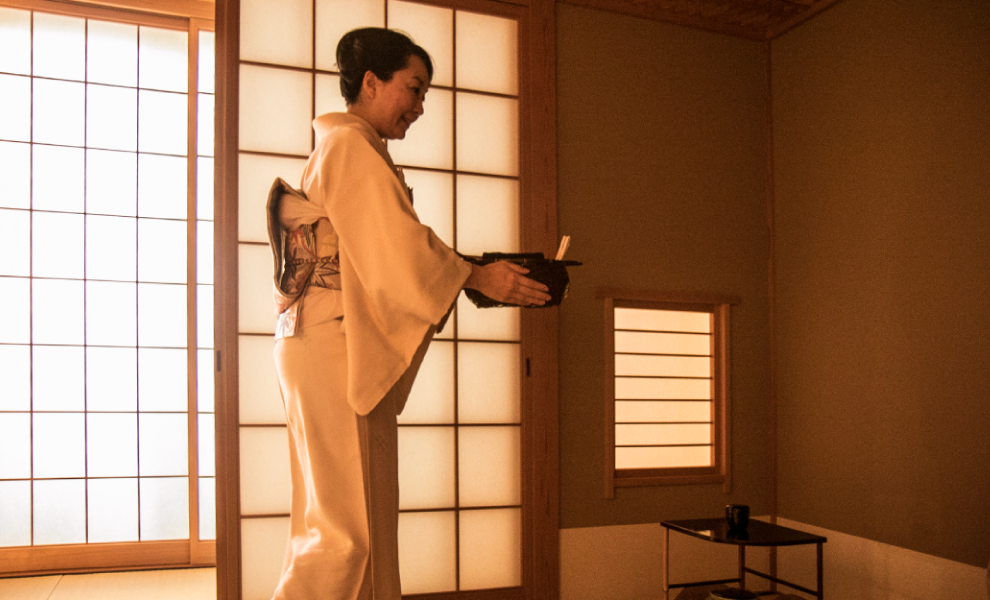
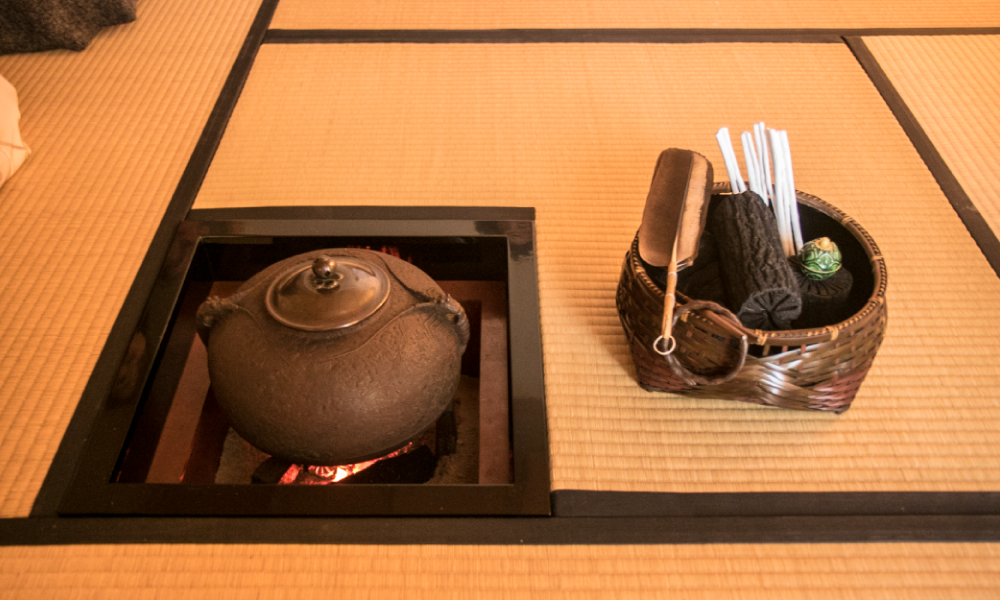
- Hoshina
- We can break the ceremony into four parts. The first is sumi-demae, the laying of the charcoal to light the fire used to boil the water. The length, size and ordering of the pieces are formalized. Practically speaking, it’s the ideal arrangement for building and keeping a fire. Aesthetically, it’s beautiful to look at. There’s a special kind of charcoal whose cut end resembles a chrysanthemum flower, and twigs that are coated with seashell powder to ignite the fire well. Moist ash is another material used. When it’s placed on the fire, the rising steam creates an updraft that helps to generate a stronger flame for boiling the water. The overall arrangement makes beautiful contrasts of color in the flames. Also, the incense burnt on the charcoal gives off a nice scent and purifies the air in the room. All of these aspects and more go into the building of the fire. It takes years to master, so you can enjoy the host’s movements as a kind of choreography. As guests observe the procedure, their anticipation for the delicious tea rises.
Kaiseki Meal
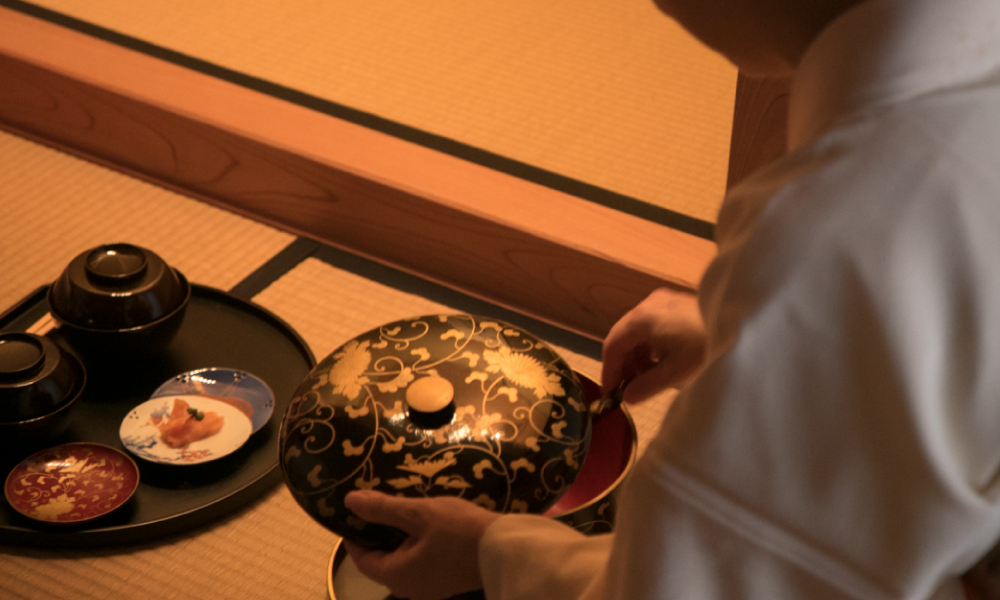
- Hoshina
- In the second part the host serves a light meal with sake. This is the origin of multicourse kaiseki cuisine. Nowadays we think of kaiseki as sashimi and all these gorgeous dishes but in fact it began with the minimalist wabicha style of tea ceremony perfected by Sen no Rikyu. His ichiju sansai menu was a well-balanced meal of one soup and three dishes, plus rice and pickles. It’s just enough to settle your stomach and prepare you for a wonderful bowl of tea. In the warmer months when the summertime furo brazier is used, the serving of the meal is done first, before the fire is prepared. Finally, the host serves omogashi — a moist sweet-bean confection that will set up your palate for the tea. Each one is an edible piece of art with a poetic name, a treat for all the senses.
- Hobonichi
- And then there’s an intermission?
- Hoshina
- That’s right. After the dessert, all the guests retire to a waiting area in the garden as the tea room is freshened and the scroll replaced with a flower arrangement.
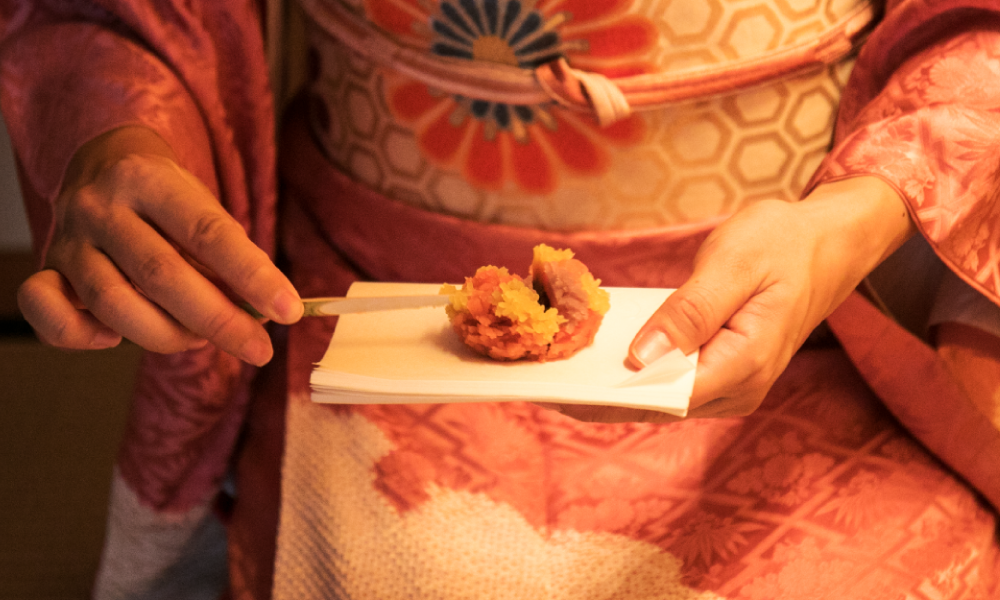
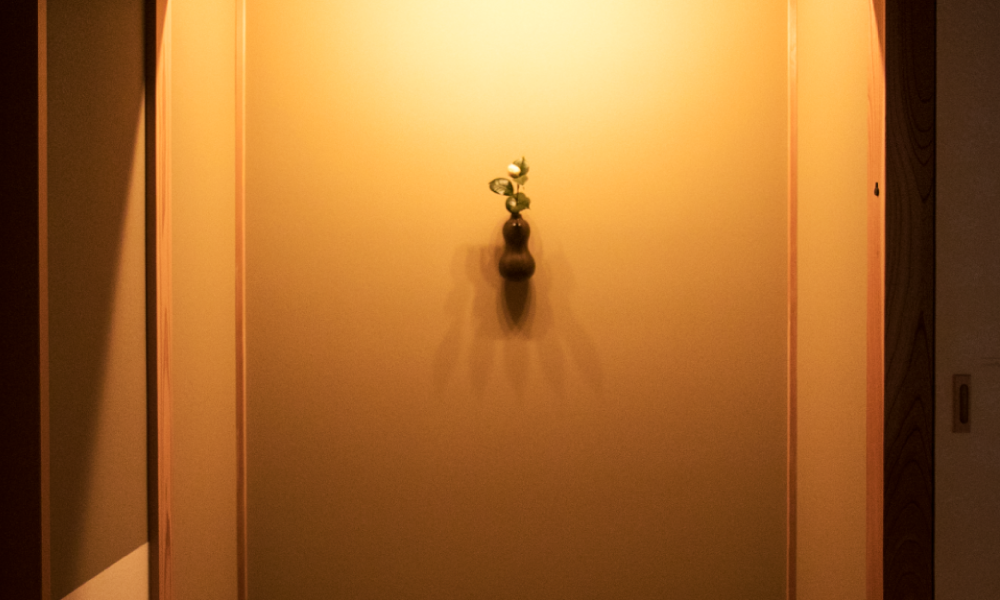
Serving of Koicha Thick Tea
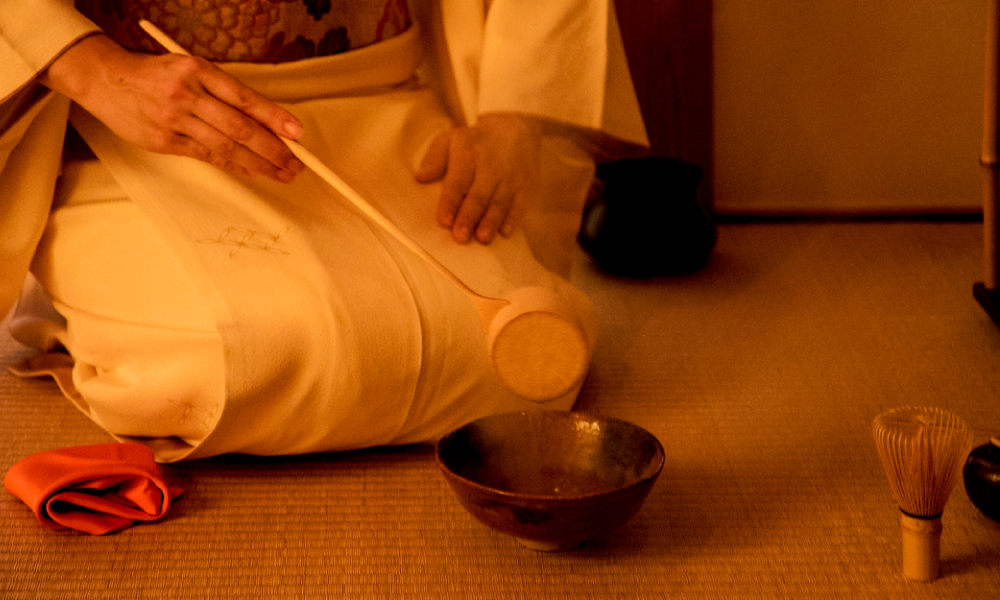
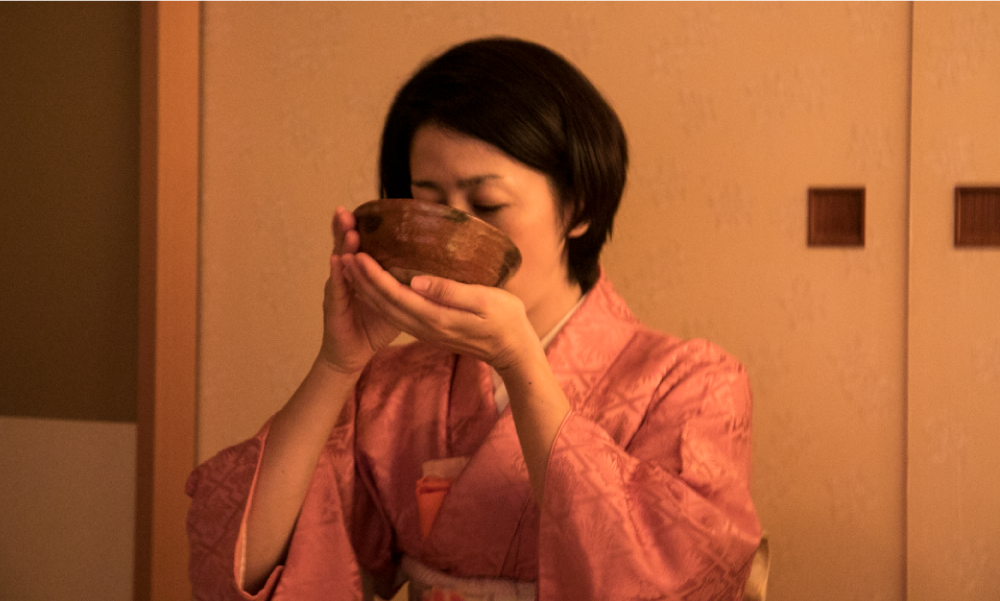
- Hoshina
- The third part of the ceremony begins with a serving of thick tea. This is the highlight of the ceremony. You might even say that everything up to this point has been designed to make this moment as delicious as possible. The same bowl of tea is shared by all guests, who pass it along in turn to the next in line. The guests’ connections with one another are deepened in this way, creating a sense of oneness or unity called ichiza konryu, the ultimate goal of the ceremony.
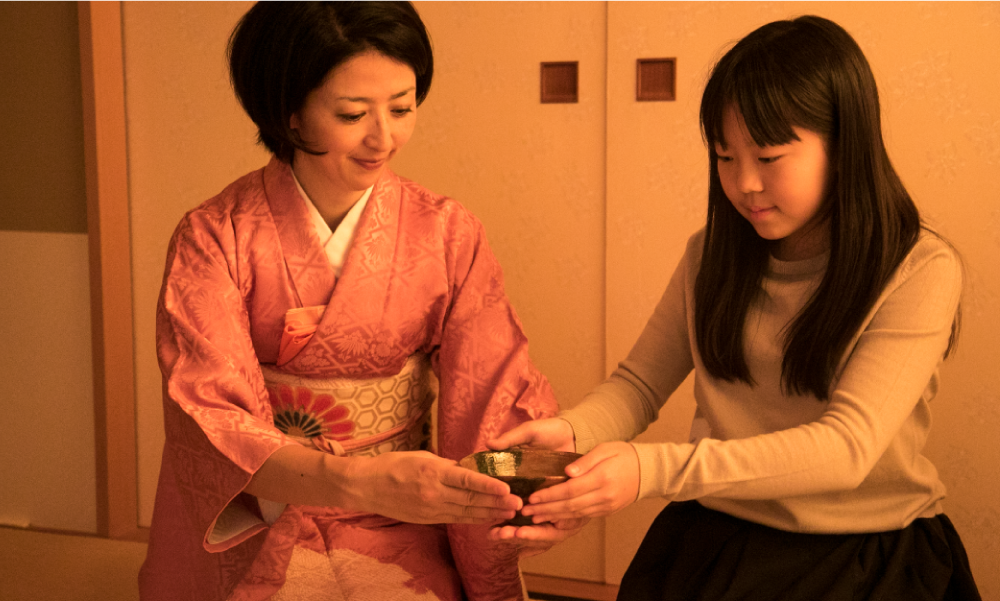
Serving of Usucha Thin Tea
- Hoshina
- And then finally the host serves higashi dry sweets with usucha thin tea. This is one last relaxing bowl — or more, as guests may request as many as they like — to enjoy together as cushions are brought out and, for those who smoke, cigarettes or pipes. At this point in the ceremony everyone is full in spirit and body. It’s a relaxed time.
- Hobonichi
- Earlier you spoke about mindfulness. Can you tell us more about that?
- Hoshina
- Yes, it relates also to what we were saying about non-verbal communication. For someone new to the tea ceremony there will be times when the meaning of some procedure, its underlying symbolism, is unclear. That’s okay. One thing you can do is pay attention to the sound of the water. Listen to it as it heats in the kettle, or as your host transfers it to the tea bowl. You might notice, for example, that hot water makes a lower note than cold water when it’s poured. Listening to the water, in anticipation of the delicious tea that will come, is one of the sensory highlights of the event.
When you are served the sweet, focus on that — its taste and texture. Appreciate the artistry of the creation, its seasonality as well as the flavor. And watch quietly the art of preparing the tea — you might notice that there are different whisking techniques used to prepare the thick and thin teas, for example. And when it’s your turn to drink the tea, focus on that — don’t worry that others aren’t drinking. Stay mindful and enjoy it. Be fully absorbed in each moment, the particular experience you are having. Also, don’t be put off by the absence of conversation at this stage of the ceremony. Sound is very important to both the host and the guests. Paying attention to it — the placement of chopsticks on the tray, the opening of a door — will tell you a lot about how things are progressing.
- Hobonichi
- When is it okay to ask questions?
- Hoshina
- When all guests have drunk the tea and the bowl is returned to the host, the concluding part of the ceremony begins. This focuses on art appreciation, and is the time to show your interest as you take a closer look at the utensils used. You might ask about the poetic names of the pieces, for example, and you can ask about their provenance — how old they are, who the makers and artisans were, or which kiln a piece of pottery comes from. The atmosphere when the koicha thick tea is served is still solemn, serene, calm but once the thin usucha has been prepared most of the procedures have been completed and so the conversation becomes naturally more relaxed.
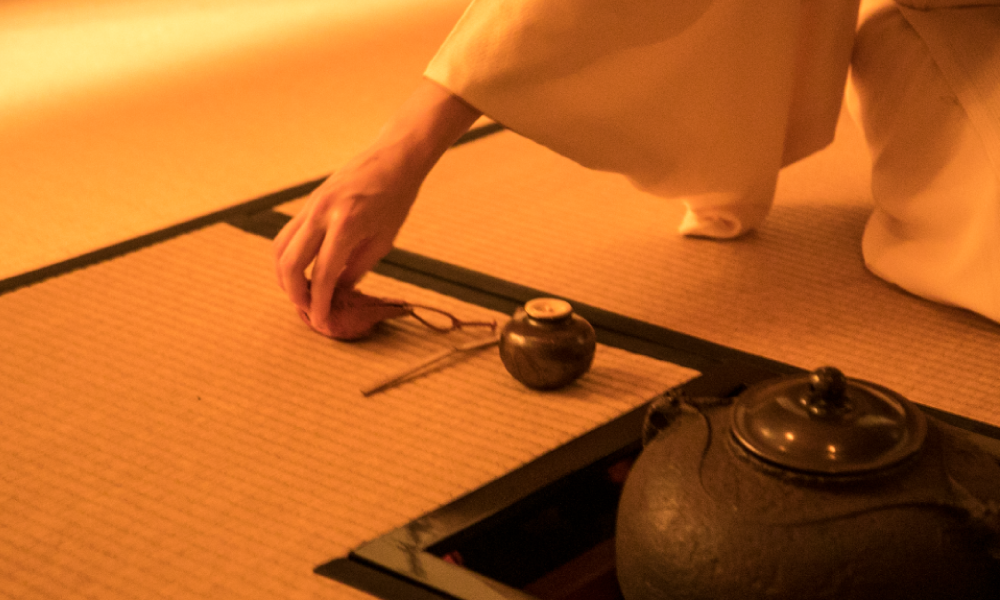
- Hobonichi
- It’s so much more close-up and hands-on than is possible in a museum!
- Hoshina
- Another aspect of the art appreciation is simply watching the performance of your host. Many of the stylized movements take years to master. Using the fukusa silk cloth, for example, she will purify the four cardinal directions as well as the two poles of heaven and earth, to channel all the energy of the universe into making a good bowl of tea. You might also notice a step known as kagami bishaku, where the bamboo ladle is held up as if it were a mirror, showing the heart’s readiness to prepare the tea well.
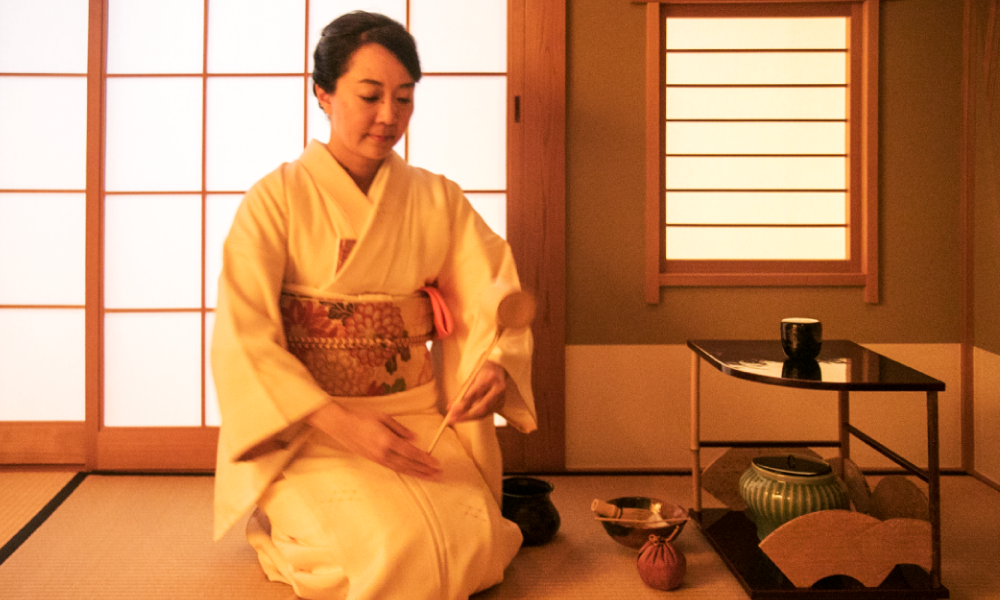
- Hoshina
- What I try to impress on first-time visitors to Japan, or to anyone who is new to the practice of tea, is that it’s very much part of our contemporary lifestyle. Compared to the olden days when it was a pastime of the privileged class, today it is much more approachable and casual but nevertheless still anchored in traditional ways and still meant for achieving an enhanced state of tranquility. If you are experiencing the tea ceremony for the first time, my advice is to remember that it’s less about following rules and more about contributing to the spirit behind the gathering — the four concepts of Wa, Kei, Sei, Jaku; harmony, respect, purity and tranquility. Having participated in that kind of communion, I hope that visitors will come away with a warmer impression of the Japanese they meet on their travels. Also, for young children and corporate workers alike, the kind of mindfulness training accomplished through the way of tea is a valuable skill. Some of my clients use the tea ceremony in their leadership and team-training programs. I like to think of it as the art of living. Whatever you experience from it is yours, your gift to bring back and carry with you. Relax and feel it.

